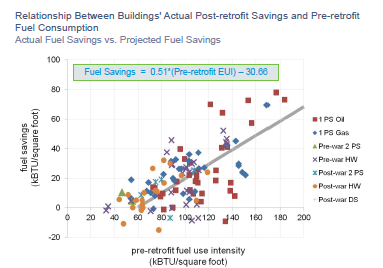Commercial, Demand Management, Energy Efficiency - December 13, 2016 - By Allison Porter
'The World's Best Coffee' and other lies: How to avoid energy-efficiency investment pitfalls
There's a great scene in the movie Elf where Buddy the Elf, played by Will Ferrell, recently banished from the North Pole, spies something that stops him in his tracks. It's a sign outside a Manhattan diner proclaiming, "World’s Best Cup of Coffee." Buddy marches into the diner with a broad smile and exclaims: "You did it! Congratulations! World's best cup of coffee! Great job, everybody! It's great to meet you."
The reason the scene is funny is because it's obviously not true. Only someone as naïve and gullible as this errant elf would believe that diner actually makes the world's best cup of coffee.
In marketing, we acknowledge that there will be some exaggeration; the delightful name for this somewhat odious practice is "puffery." Puffery is defined by the courts as "exaggerated advertising, blustering and boasting upon which no reasonable buyer would rely."
But what if a buyer has no way of knowing whether a marketing promise is reasonable or not?
That's exactly the problem we face with energy-efficiency upgrades in commercial buildings. The people making investment decisions generally are not experts in performing the detailed calculations required to translate engineering details into energy metrics and then into financial metrics. These decision-makers have to rely on calculations provided by others to judge whether an investment is worthwhile. And, unfortunately, those calculations are often incorrect.
How often are they incorrect? We have some data to answer that question. In 2012, the Deutsche Bank Foundation released a study of 231 energy efficiency retrofit projects in Deutsche Bank's multifamily (apartment building) portfolio. The study found an overall realization rate — the ratio of projected energy savings to actual savings — of only 61%. In other words, these projects only returned 61 cents for each dollar they were expected to save.
What went wrong?
The graph below compares each project's actual savings with its projected savings. (The colors and symbols categorize the buildings according to their heating systems). The diagonal line is the ratio of 1:1, meaning that that actual savings were equal to expected savings.
 |
Source: Deutsche Bank |
It's reasonable to expect a certain amount of error in any kind of projections, and if it was simply standard, unbiased calculation error, we'd expect to see about the same number of projects above the 1:1 line as below it.
But that's not what the graph shows. Two-thirds of the projects fall below that line. Some of them even fall below the zero line, which means that energy costs went up instead of down after the project! If I had invested in the project that was supposed to deliver over $1,200 per unit in savings but instead resulted in higher bills (the red square at bottom right), I'd certainly be miffed.
The Deutsche Bank Foundation study offered three main reasons why the projects failed to deliver their expected savings:
- Improper execution. The equipment was installed incorrectly, for example.
- Unexpected post-retrofit behavior. This "unexpected" behavior took two forms. First, the building staff did not know how to properly operate the new equipment. Second, the residents took actions that canceled out the retrofit's energy savings. For example, the building installed a new, more efficient heating system and the residents went out and bought space heaters.
- Savings over-projections. The study's authors put this very politely, but there's no disguising it: the energy projections were unrealistically high. The study notes that the savings estimates tended to make optimistic assumptions and depended upon achieving ideal conditions.
These conclusions were specific to Deutsche Bank's multifamily portfolio, but based on my experience with thousands of commercial buildings across the U.S. and Canada, they also apply to office, retail, and industrial buildings.
Why were savings overwhelmingly over-estimated?
The fact is that most energy savings calculations are performed by people who are trying to sell something. A lighting manufacturer provides savings estimates for lighting upgrades. An HVAC contractor calculates potential energy savings from replacing an old boiler.
For all intents and purposes, these energy savings calculations are marketing documents. Which means we should absolutely expect to encounter our old "friend," puffery. Just like the diner with the "World's Best Cup of Coffee," vendors want you to believe that they are offering the "World's Best Energy-Efficiency Project."
Most corporate real estate executives and financial decision-makers have already figured out this fact. That’s why they often fail to invest in energy-efficiency retrofits, even when the project seems to make sense on a purely financial basis. They simply don’t trust that an energy efficiency project will deliver on its promise.
Unfortunately, these executives are leaving money on the table. Energy efficiency is one of the easiest and least expensive ways to cut costs and boost a company's operating margins.
How can a corporate executive distinguish energy efficiency projects that will pay off from the ones that are full of hot air (and not in a good way)? Here are three rules to follow:
- Work with trusted providers. A vendor that has proven reliable over time is less likely to jeopardize the business relationship for a quick sale. An outsider, by contrast, has nothing to lose by making outlandish claims about its products.
- Trust, but verify. Conduct measurement and verification (M&V) on energy-efficiency projects you pursue. In addition to providing useful data for future decision-making, good M&V can identify problems that limit a project's performance, such as incorrect installation or inadequate staff training.
- Set reasonable caps. Using data from your M&V efforts, identify rules of thumb to establish reasonable limits for energy savings expectations. If a potential project's projected results exceed your rule of thumb, reduce them to a more realistic level before deciding whether to proceed.
Editor's note: This column has been excerpted and adapted from Allison's remarks at the U.S. Energy Information Agency's 2016 Energy Conference.
 Allison Porter is a commercial real estate veteran providing technical advice on energy efficiency and building performance to Cushman & Wakefield and other large organizations. She was previously vice president and head of the sustainability services unit at Cushman & Wakefield, a global commercial real estate services firm. Prior to joining Cushman & Wakefield, Allison was an associate in the energy services division of Cadmus Group, a national environmental engineering firm. In this role, she evaluated and advised utilities on their energy efficiency and finance programs. Over the past 16 years, Allison has served in various roles within the financial and commercial real estate industry including as an analyst at Wachovia Securities (now a division of Wells Fargo), analyst and transaction manager with JLL, and development manager and director of sustainability for Vornado Realty Trust. While at Vornado, she managed world-class real estate development projects in the Washington, D.C., metro area and developed and implemented corporate sustainability strategies for an 80-building D.C.-area portfolio. Porter is also a Smart Energy Decisions advisory board member.
Allison Porter is a commercial real estate veteran providing technical advice on energy efficiency and building performance to Cushman & Wakefield and other large organizations. She was previously vice president and head of the sustainability services unit at Cushman & Wakefield, a global commercial real estate services firm. Prior to joining Cushman & Wakefield, Allison was an associate in the energy services division of Cadmus Group, a national environmental engineering firm. In this role, she evaluated and advised utilities on their energy efficiency and finance programs. Over the past 16 years, Allison has served in various roles within the financial and commercial real estate industry including as an analyst at Wachovia Securities (now a division of Wells Fargo), analyst and transaction manager with JLL, and development manager and director of sustainability for Vornado Realty Trust. While at Vornado, she managed world-class real estate development projects in the Washington, D.C., metro area and developed and implemented corporate sustainability strategies for an 80-building D.C.-area portfolio. Porter is also a Smart Energy Decisions advisory board member.
Stay Up-To-Date












